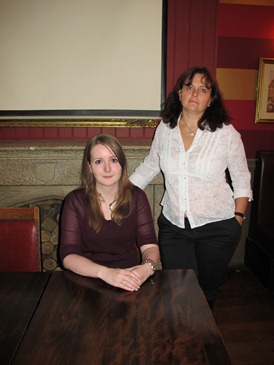What do you get if you put a group of crime writers, bloggers, a forensic anthropologist and a forensic entomologist together in one room? Sounds like the start of a very bad joke, doesn’t it? In fact it was the formulae for a very good London Chapter meeting at the local haunt of The George in London's the Strand.
It also happened to be the first meeting to invite non-members and encourage them to sign up as associate members. Michael Ridpath introduced the evening’s guest speakers Heather Bonney and Amaret Whitaker of the Natural History Museum. The experts took to the stage and their talk was accompanied with slides.
First up was the “Bones” lady. Heather works in the Palaeontology Human Remains Unit, where there are around 20000 sets of human remains kept for research. She specialises in the study of skeletons for legal research and in the use of forensic anthropology. She regularly undertakes forensic casework for police forces throughout the UK. Heather cited that she could be called in because of an unexpected discovery ie a decomposed body, mass casualties, recovery of burnt victims and dismemberment.
Among her cases she recalled that bones were found in the local park by a group of kids playing Time Team. One little boy brought her a shopping bag of bones that he had collected. Further investigation found that it was an old Blitz site. And the bones were that of the casualties.
Heather explained that her primary task is identification and that there are the BIG 4 answers she searches for: age, sex, ancestry and stature.
Before started her talk “Bug” lady, Amaret Whitaker, did warn us not to take photos during her talk and that some of the slides were quite graphic. I noticed a few people move to the edge of their seats, whilst others were ready to shield their eyes. First up
was the Case of the Rotten Kippers, whereby it turned out that a malicious ex-work colleague posted rotten kippers through the letterbox of their employer and the case was solved because multi-coloured maggots were found rather than a single species. A skull of an unusual animal was sent to the museum claiming it to be that of the Beast of Bodmin Moor. Upon examination an egg case was found lodged in the skull; it was that of a maggot usually found in a hot country. It was a big cat rather than the fabled beast.
Amaret then told us about the first time forensics was used in the UK to convict a criminal. Dr Buck Ruxton was charged with the murder of his wife and housemaid ( a potential witness) in Lancaster, England. Ruxton dismembered their bodies and disposed their body parts in and around the town of Moffat, Dumriesshire. The body parts were found but foolishly Ruxton had wrapped the human flesh in a local newspaper; and on his return home he collided with a cyclist in Kendall. These two incriminating factors secured Ruxton's fate. Ruxton was arrested tried in the Manchester High Court. He was found guilty and hanged at Manchester on 12th May 1936.
Amaret has also worked at the anthropological research facility in Knoxville, Tennessee better known as the Body Farm. The facility is run by Dr William Bass, who with Jon Jefferson make up the writing team of Jefferson Bass. Strangely enough, Heather was rather dismissive about their fiction.
In all, it was a fascinating and educating evening. The CWA plan more evenings such as these, and I will most definitely be there, and if you are offered the chance, please take it.

Heather Bonney and Amaret Whitaker
Photo © Mike Stotter
why wife cheated
read online affair
i cheated on my husband and got pregnant
sigridw.com should i cheat on my husband
I cheated on my husband
site wives who cheat
discount coupons for cialis
read cialis discounts coupons
information on abortion
link abortion hotline
naltrexone implant australia
open who can prescribe naltrexone
revia manufacturer
read naltrexone depression treatment